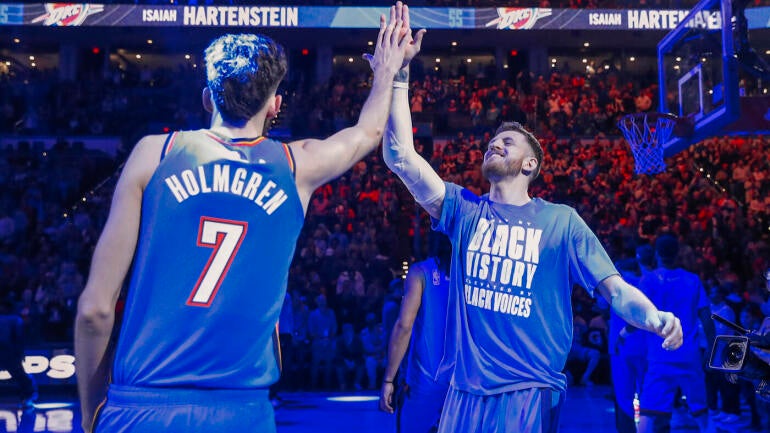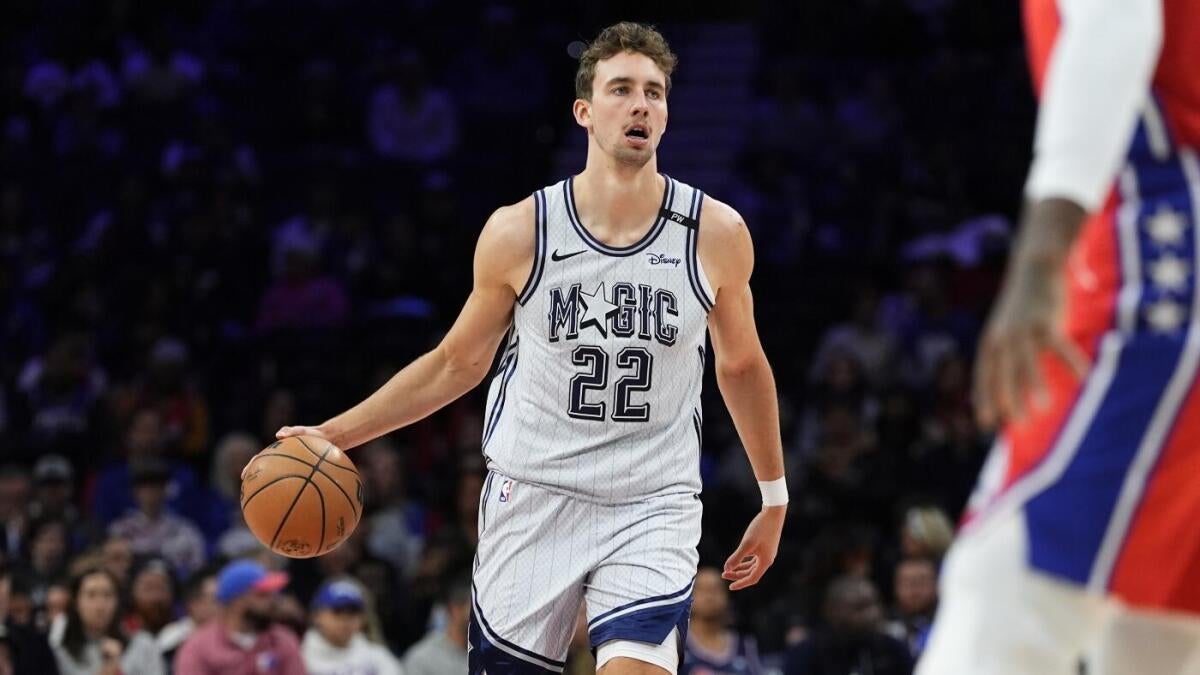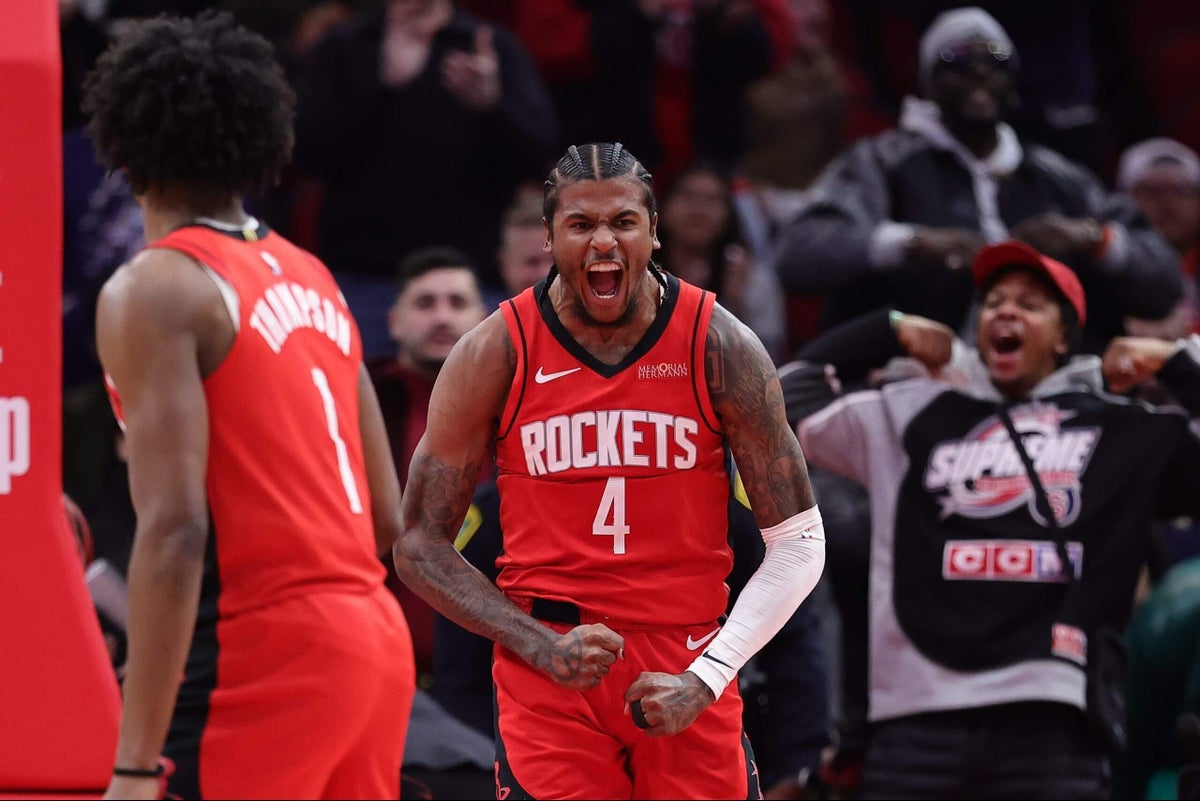
With seven games left until playoff time, the double-big lineup remains relatively new for the Oklahoma City Thunder. The 7-foot-tall Isaiah Hartenstein broke his hand in the preseason and the 7-foot-1 Chet Holmgren broke his pelvis in November, so the two didn’t share the court in a regular-season game until the week before the All-Star break. They’ve still played only 269 minutes together in 16 games, so Oklahoma City’s plus-15.0 net rating in those minutes is not necessarily cause for celebration.
That sample is more than enough, though, to see that this version of the Thunder is a different beast. To get a pretty good sense of why they paired Hartenstein and Holmgren, you can just watch the first 90 seconds of their game in Sacramento last week.
On their first offensive possession, Hartenstein found Holmgren cutting off a back screen for an easy layup. On their second, Hartenstein handed it off to Holmgren for a 3 on the move. Then the Thunder got back on defense and the two bigs converged on a rolling Domantas Sabonis, who kicked the ball out. Keegan Murray drove the closeout, Holmgren peeled off to Sabonis and Hartenstein forced Murray into a contested, late-clock, off-the-dribble midrange jumper.
Before the Thunder’s game at Barclays Center on Feb. 26, Brooklyn Nets coach Jordi Fernandez said he did not anticipate playing centers Nic Claxton and Day’Ron Sharpe substantial minutes as a tandem. “I’m not going 1995 NBA basketball and playing with two bigs,” Fernandez said. What OKC is doing, though is not a throwback. It is the future.
Hartenstein, who grew up playing on the perimeter, is an “unbelievable ballhandler and passer,” Fernandez said. “I don’t know if I can call Chet a ‘big’ — he’s a 1-through-5 basketball player. So yeah, it’s very different.”
The Thunder have started Hartenstein and Holmgren together in all but two of the games in which they’ve both been available. They’ve faced opposing lineups of all different shapes and sizes, and that is deliberate.
“We’re trying to learn it and learn what the trade-offs are,” Oklahoma City coach Mark Daigneault said. “Once you understand the trade-offs of a lineup, you can figure out when you want to deploy it, when it’s a strength and when you need to pull back.”
Some of the benefits are already resoundingly clear: The jumbo lineup has annihilated teams on the glass — its 32.4% offensive rebounding percentage is better than every team’s except the Houston Rockets’, and its 79.7% defensive rebounding percentage is significantly better than the Los Angeles Clippers‘ league-best mark. With Hartenstein and Holmgren on the floor, the Thunder have shut down the paint — only 18.8% of opponents’ shots have come at the rim, according to Cleaning The Glass — and forced long 2s more frequently than any team has.
The costs are also coming into focus: When supersized, OKC has had a slightly below-average turnover rate (as opposed to an elite rate with only one big), and its transition offense has been worse than every team’s except the Charlotte Hornets (as opposed to the best in the league with only one big), per CTG. It has taken far fewer above-the-break 3s, too, and on the other end, it has forced far fewer turnovers (the equivalent of the lowest mark in the league, as opposed to an elite one with only one big) and allowed a higher volume of 3s (and corner 3s) than any team.
That night in Brooklyn, Holmgren tried two lob passes to Hartenstein that didn’t connect. Afterward, he said he had to keep working on it. “I’m a big believer in f—ing it up until you get it right,” Holmgren said. In this case, he’s sometimes “really eager to throw it, where I need to play more aggressive as a scorer and that’s going to open up the lob.” Since then, the Thunder have scored on a few Holmgren-to-Hartenstein alley-oops; against the Kings, they got one out of a set play to start the second half.
The chemistry is coming along, and the combination is “going to be big for us,” Hartenstein said — figuratively, I think.
‘A powerful combination’
On defense, the sheer size and length of the Hartenstein-Holmgren duo is imposing. The Thunder can play a more conservative style rather than relying on forcing turnovers, and they can switch their bigs without being too worried about protecting the rim and the glass. If one of them is guarding an action on the perimeter or gets beaten off the dribble, the other can cover for him.
Typically, Hartenstein guards the other team’s nominal center, but they’ve experimented with a 2-3 zone and funky matchups. Against the Charlotte Hornets, when Holmgren guarded the 290-pound Jusuf Nurkic and Hartenstein roamed off of wing Josh Green, it felt like they were daring Charlotte to turn its offense into a procession of post-ups. In two games against a Minnesota Timberwolves team that was missing Rudy Gobert and Julius Randle, Daigneault put Holmgren on the 6-foot-4 Jaylen Clark, Hartenstein on Jaden McDaniels and Jalen Williams on 6-foot-9 center Naz Reid.
Daigneault knew going into those Wolves games (and others against smaller teams) that Hartenstein and Holmgren would find themselves in uncomfortable situations. Daigneault wanted to put them in rotation, though, in order to test their limits. It would be “irresponsible of us,” he said, not to find out everything there is to know about this look — and this team, for that matter.
Against the Milwaukee Bucks, Hartenstein took the Giannis Antetokounmpo assignment — and the bumps and bruises that come along with it. Holmgren matched up with forward Kyle Kuzma, but his real assignment was to muck the Bucks’ offense up. On the first possession of the game, Antetokounmpo handed the ball off to Damian Lillard, who tried to turn the corner. Holmgren helped off of Kuzma on the strong side — normally a no-no — and then recovered to contest the corner 3 when Lillard kicked it out.
Milwaukee got nothing going in that game, and OKC limited Antetokounmpo to 21 points. “I think today you really saw how much that big lineup can really help,” Hartenstein told reporters afterward. Daigneault added that having Hartenstein on Antetokounmpo with Holmgren lurking behind him “specifically is a powerful combination.”
The trigger man
Oklahoma City knew it had a rebounding problem last season. The challenge was to solve it without creating a host of new issues. Hartenstein fit the bill because he does not approach offense like a traditional big man.
“It’s not like I’m just going down the court posting up, playing slow,” Hartenstein said. “I’m still in actions all the time, so it’s not like a stagnant big lineup.”
Hartenstein is one of the NBA’s premier point-centers. “We haven’t had a big like him, especially offensively,” Daigneault said. He is not a floor spacer in the traditional sense — this season, he has attempted 18 3s and missed all of them — but he doesn’t prevent you from playing 5-out. When he catches the ball above the break or at the elbow, the paint is generally open and his teammates know he’ll find them on cuts. He can create advantages as an off-ball screener and a handoff hub.
“I’m a trigger,” Hartenstein said. “A trigger in most of the actions. I’m in different positions, and I think [Daigneault] does a good job of manipulating the other team’s defense.”
Hartenstein is dangerous with the ball in his hands. He’s a skilled facilitator, but he mixes in “keepers,” fake dribble-handoffs that often catch defenders off guard.
He’s dangerous in the short roll because of his passing:
And because of his signature shot: a high-arcing floater.
“He screens to contact and really frees up the guards, which puts him behind a lot of plays,” Daigneault said. “And that’s where it’s deadly ’cause the guard’s going downhill and then can drop it back to him and he can find that shot after you’re explored other parts of the pick-and-roll game.”
In a league where teams are primarily concerned with guarding the rim and the 3-point line, some teams effectively cede shots from floater range. Nikola Jokic, Nikola Vucevic and Bam Adebayo feast on these shots, but, the vast majority of the time, Hartenstein himself isn’t too worried about the opposing big putting one up when he’s defending the pick-and-roll.
“There’s not a lot of bigs who consistently do it,” Hartenstein said. “I feel like, especially against those heavy-drop bigs, if you can consistently make it, it’s a great weapon to use.”
The (really, really) big wing
When the Thunder have the ball, Hartenstein does not think of Holmgren as another big.
“Offensively, I think he’s very skilled, he plays on the perimeter,” Hartenstein said. “It’s not like we’re getting in each other’s way.”
Both bigs are “see-it-and-fix-it type guys,” guard Cason Wallace said. “So if they’re both on the floor, they’ll be able to see the situation and know how to play basketball.”
Oklahoma City has empowered Hartenstein to play his game, and it has effectively forced Holmgren to show off the different parts of his. At times, Holmgren does big-man stuff, like screening, catching lobs in the dunker spot and operating in the short roll, but he’s also running the occasional pick-and-roll and making plays off the dribble:
This, in addition to the rare combination of shot-blocking and 3-point shooting, has always been the promise of Holmgren. The Thunder like to run him off pindowns from Hartenstein, too:
Holmgren’s development as a creator is one of the most exciting things happening in Oklahoma City. It’s also a work in progress. Some of his drives are much smoother than others, and playoff opponents are going to be physical with him and make him prove he can consistently punish smaller defenders.
Against the Chicago Bulls on Monday, Holmgren grabbed a defensive rebound, then pushed the ball coast to coast and finished through contact. In that same game, though, he was stifled several times by Bulls rookie Matas Buzelis, including once in that exact same scenario:
At a recent practice in Oklahoma City, Holmgren told reporters that there has been a learning curve playing the 4 spot on offense, in terms of “figuring out the rhythm and getting the timing right with all the guys and understanding where my spots are during the game.” He added, though, that he’s “really just playing a wing spot,” and the Thunder are more or less positionless anyway. When Hartenstein is on the floor, acting as the trigger man, everybody else is “flying around and just making reads,” which is difficult for opposing teams to prepare for.
“It’s really helpful that we’re all all over the place and we can all do everything,” he said.
‘That’s what makes us dangerous’
When the Thunder signed Hartenstein, general manager Sam Presti told reporters that they wanted to be “more diverse” stylistically. In this respect, the difference is most obvious on the offensive end, where the Thunder have been less dependent on their drive-and-kick game and the individual brilliance of Shai Gilgeous-Alexander. Beyond that, though, they have become the kind of team that can shift shapes. Earlier this year, when Hartenstein, Holmgren and Jaylin Williams were all hurt, they sized all the way down, with the 6-foot-5 Jalen Williams acting as their rim-protecting “center.” It went surprisingly well.
“The luxury of our team is you can have so many different ways to play,” Hartenstein said. “We can go full small. We can go Chet at the 5, me at the 5, us together. I think there’s a lot of different ways that we can approach the game, and I think having a coach like Mark that’s open to adjusting and open to not sticking with one thing, one lineup, I think that’s what makes us dangerous, especially in the playoffs. Because that’s when you really have to adjust.”
Oklahoma City has added to its menu, but it hasn’t abandoned its ethos. In some ways, the double-big look jibes with how they’ve approached offense for years. If the “guards” are screening and playing in the dunker spot, then why shouldn’t the “bigs” be making plays from the perimeter?
The Thunder have the league’s best record (63-12), and they could finish the season with the best net rating in NBA history, but they lost a tight second-round series as the top seed last year. In theory, their new look will make them more capable of overcoming poor shooting nights in the playoffs this time around. It should make them more able to counter opposing team’s adjustments and make defenses pay for blitzing Gilgeous-Alexander, too. Oklahoma City is still figuring out all the ways it can use Hartenstein and Holmgren together, but this hasn’t been a chore. They’re both “open-minded to anything,” Daigneault said, and they believe this will work.
“You can move everything around, and they’re just going to learn, they’re going to communicate through it,” Daigneault said. “They’re both very communicative people, so they communicate with each other and their teammates very well, and they’re going to give it the best chance to have the best look. And that’s comforting. As a coach, it gives you confidence to bet on it.”


